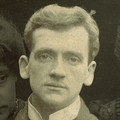[?Walter Bayes], ‘The Camden Town Group’
Athenæum, 9 December 1911.
THE CAMDEN TOWN GROUP.
The second exhibition, at the Carfax Gallery, of this Society is dominated by Mr. Walter Sickert, who in his two chief works, Mother and Daughter (12) and Carolina del’ Acqua [sic] (14), by his grasp of the principal angles in space and his refusal to control detail of form with a nicety proportionate to the exactitude with which he realizes those principal angles, achieves an extraordinary unity. All the other pictures seem by comparison to be falling slightly to pieces, the works which stand the comparison best being Mr. Gilman’s two nude studies (20 and 22), M. Pissarro’s The Turban (44), and certain slight colour-studies by Mr. J.D. Innes (7–10). Mr. Gilman’s work is very similar to that exhibited by Mr. Spencer Gore alongside (15–18), but in the present instance shows more intense conviction. He is inclined to insist on the force of reflected lights without indication within the limits of the picture of what occasions them, and this in conjunction with an evident determination to register all the planes of nature makes his work somewhat over-modelled. This is particularly noticeable in the faces, of which the planes to be painted should sort themselves out surely afresh under any given effect of light, while the rest are left to be inferred. It is by the definite selection of emergent differences, and as definite ignoring of the others, that a few tones consistently used become more completely suggestive than a number of miscellaneous ones. Despite these criticisms we must recognize the great promise shown in an art so full of vigorous research as that of Mr. Gilman. There are few exhibiting artists who come to their business with so much zest. He has sufficient instinct for handsome painting to acknowledge a unit of scale beneath which small detail is ignored. He might perhaps acknowledge as a corollary to this a unit of delicacy of angle beyond which lines might be taken as parallel. If he did this, there would ensue a bolder grouping of planes according to their tilt throughout the picture, which would make for simplicity of design, and the artist might ultimately come to see that it is these groupings, however succinctly characterized, and not the individual tones of which they consist, which are his real subject-matter.
Other exhibitors – Mr. Bevan, Mr. Ratcliffe, Mr. Drummond, and Mr. Manson – may be classed more or less as followers of Mr. Gore, Mr. Drummond using his technique of spots, perhaps for reasons of nationality, rather for variety than for simplification. Mr. Wyndham Lewis’s exhibits appear to us a somewhat formless compromise between two conventions hardly as yet ripe for criticism.
© Estate of Walter Bayes
How to cite
[?Walter Bayes], ‘The Camden Town Group’, in Athenæum, 9 December 1911, in Helena Bonett, Ysanne Holt, Jennifer Mundy (eds.), The Camden Town Group in Context, Tate Research Publication, May 2012, https://www

